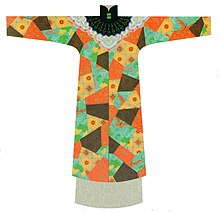Rice field (fashion)

Rice Paddy is a design style inspired by the different geometric shapes of the rice paddy (triangular to square, diamond to rectangular).
Historical rice field clothes
The shapes of the rice fields were integrated into their fashion creations by early Chinese “fashion designers” in the Tang and Ming periods. At that time so-called rice field clothes were created; Costumes composed of many pieces of woven brocade. At first the patterns were arranged very neatly, later more and more chaotic. The procedure could also be described as a kind of Chinese patchwork , which has been popular since then. A fitting contemporary quote reads: “Learn the art of tailoring from the rice fields” (Tang poet Wang Wei ).
Rice field made from ties
A modern example is the tie coat from the winter collection of the fashion design course at HAW Hamburg . Here, the aspect of sustainability was also used: The "rice fields" were put together from old ties from the last colorful epochs of fashion and thus form wedges that run into the bust darts in the front of the coat and into the center back. The harmonious color combinations of the individual tie patterns make the coat so special. The coat can also be turned around, on one side shiny fabric is juxtaposed with woolen ties, on the other side woolen fabric is contrasted with shiny ties.
3D rice field effect
If the "rice field effect" is not to result from color-contrasting motifs, but rather is created plastically, one speaks of "3D rice fields". Three-dimensional structures are created when the cut pieces are not sewn flat against each other, but butt against each other as spikes and then stand out from the flat surface. The different threadlines ensure sufficient contrasts so that you can limit yourself to a single fabric. In the model visible here, a few “rice fields” are partially highlighted in a different color.
literature
- Zhou Xun and Gao Chunming: 5000 Years of Chinese Fashion , Ernst Wasmuth Verlag, ISBN 978-3803050472 .


